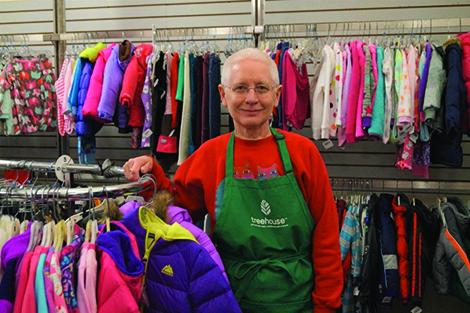Understatement: ‘I’m not going to do a lot of playing retirement’
Ann Huber and her late husband, John, originally became licensed foster parents to provide in-home respite care for a developmentally disabled daughter of a friend. One phone call later, that decision would turn into a lifelong passion.
“I got a call to see if I would do respite care for a little girl from Issaquah,†Ann said. “We quickly realized that her long-term placement wasn’t a safe environment and reported it to Child Protective Services. Because we were some of the only adults she knew, we were asked to take her in long-term.â€
That led Huber to Treehouse, a non-profit organization based in Seattle that provides support for more than 7,000 Washington children in foster care.
“My first involvement with Treehouse was shopping in their free store†that provides clothing, school supplies, books, toys and other essentials for foster kids, Huber said.
Ann and John would go on to provide care for infants and toddlers with special needs in their own home for 12 years. When they decided they were no longer able to provide 24/7 care, Ann’s work with Treehouse’s free store began. She is now one of the organization’s most dedicated volunteers.
“As we were moving into grandparenting the two little boys who had been in our care, I checked out volunteering in the store,†Ann said. “I know from my own personal experience how essential the resources are that Treehouse provides. The money foster parents get from the state for these kids comes nowhere near covering some of the most basic expenses.â€
Now in her eighth year at Treehouse, Ann has contributed 12,000 hours volunteering. That total stands out even at an organization that prides itself on more than 2,500 volunteers (many over the age of 55) lending a hand annually. With more tenure than most of the full-time staff, she’s taken on more and more responsibility through the years. She now manages the entire infant and toddler department of the store, which is located on the first floor of Seattle building that also houses the Treehouse offices.
“I’m not a person who’s going to do a lot of playing all day in retirement. I’ve always been better at working than playing,†Ann said. “This is a great outlet for what I really like to spend my time doing. One of the fun things is being in the environment with primarily younger people. Having relationships with young people that aren’t family is really cool, and everyone at Treehouse is committed to this mission.â€
Ann’s dedication to children in foster care and her passion for helping comes directly from her belief—one shared by Treehouse—that the community as a whole is responsible for all of its children. For Ann, volunteering is a way to directly live out this belief and make an impact on the lives of youth and their caregivers.
“To provide them with the best shopping experience and the best stuff when they shop, that’s what keeps me going,†Ann said. “We’re changing our community in a very positive way. Every kid who launches successfully into adulthood as opposed to repeating the cycle they were born into makes our community better.â€
The store carries clothing for all sizes of children, from infants to teenagers. Foster caregivers and older foster kids can pick out whatever they need. The public can donate new and like-new clothes and supplies at the back of the store building at 2100 24th Ave. S. Information about donations and other ways of being involved with Treehouse is available at treehouseforkids.org and 206-767-7000.
Founded in 1988 by social workers, Treehouse addresses the needs of foster kids for school and other essential support. One of its academic programs, called Graduation Success, has education specialists who help middle school and high school students in nine counties (including Pierce and King) develop graduation and post-graduation plans.

